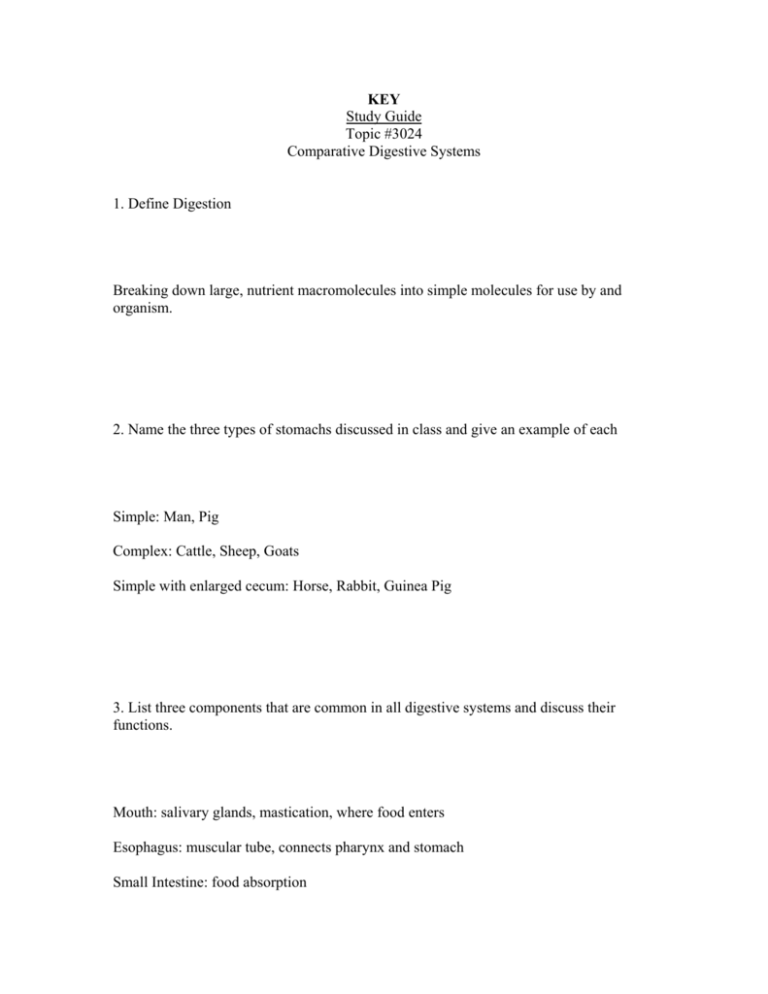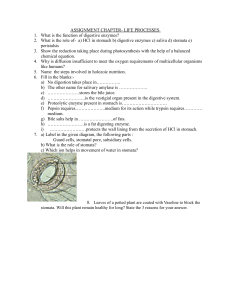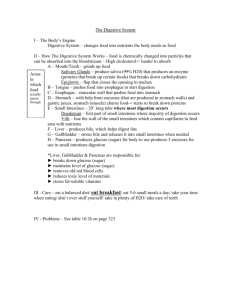KEY Study Guide Topic #3024 Comparative Digestive Systems 1
advertisement

KEY Study Guide Topic #3024 Comparative Digestive Systems 1. Define Digestion Breaking down large, nutrient macromolecules into simple molecules for use by and organism. 2. Name the three types of stomachs discussed in class and give an example of each Simple: Man, Pig Complex: Cattle, Sheep, Goats Simple with enlarged cecum: Horse, Rabbit, Guinea Pig 3. List three components that are common in all digestive systems and discuss their functions. Mouth: salivary glands, mastication, where food enters Esophagus: muscular tube, connects pharynx and stomach Small Intestine: food absorption Large Intestine: water absorpion Liver: produces bile, breaks down fatty acids Pancreas: produces and secretes digestive enzymes 4. Discuss digestion and what occurs during digestion in the simple stomach or monogastric digestive system. Digestion includes muscle contraction and secretion of enzymes to break down food. In the simple stomach, gastric enzymes break down protein in the stomach, liver and pancreatic enzymes break down fats in the small intestine and intestinal enzymes break down carbohydrates and proteins in the small intestine 5. List the four components of the ruminant stomach and give one characteristic or function of each component. Rumen: makes up 80% of system in mature and 30% in young bovine Reticulum: prevents indigestible objects from entering the stomach Omasum: water absorption Abomasum: the true stomach 6. Describe what occurs during regurgitation in the ruminant digestive system. Regurgitation is the first step in rumination. Large quantities of roughage are consumed and chewed just enough to swallow. After swallowing, regurgitation (cud chewing) takes place and food is re-chewed. 7. Describe the role of Hydrochloric acid in the monogastric digestive system. Hydrochloric acid breaks down nutrients in the stomach. 8. What organs are found in the avian digestive system, thus separating them from other species? What are the functions of these components? Proventriculus: provides digestive excretions Gizzard: very muscular, used to grind food Crop: used for food storage 9. Discuss the equine digestive system in terms of its difference(s) as compared to the monogastric system of humans and pigs. The main difference in the equine system is the enlarged cecum which is adapted for the ability to consume and convert large amounts of roughages into usable nutrients. 10. Recall the function of the two accessory organs, pancreas and liver. Pancreas: produces and secretes digestive enzymes, produces insulin which regulates carbohydrate metabolism Liver: produces bile that breaks down fatty acids, stores iron and carbohydrates in the blood











